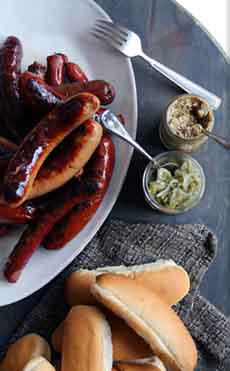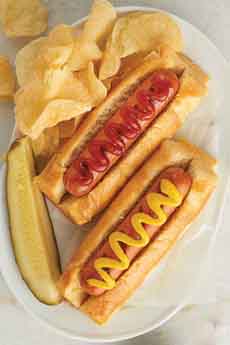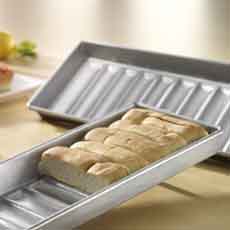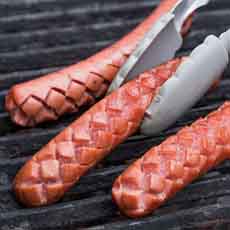Homemade Hot Dog Rolls & The Difference Between Rolls & Buns
 [1] Classic hot dog rolls have tapered edges (photo courtesy Murray’s Cheese).
|
Following up on yesterday’s homemade hamburger roll recipes, today we present the hog dog roll recipes from King Arthur Flour. The hot dog is an American term for what initially was called a frankfurter, a style of sausage favored in Frankfurt, Germany. It was brought to the U.S. by German immigrants in the 1880s. Here’s the history of hot dogs. While any hot dog or hamburger dough recipe works in any hot dog pan, you do need special baking pans to shape the rolls. First, decide if you want to make rolls with classic rounded edges (photo #1) or the straight-edge New England style (photo #2). We prefer the latter because it’s also the classic lobster roll style (lobster rolls originated in New England); and perhaps more importantly, the straight edges get crisp when toasted. Next, decide on the size of the pan. We vote for the larger, 24-bun size. If you won’t use all of them, freeze the rest. The difference between buns and rolls is below. Also take a look at: This classic recipe can be used for hot dog or hamburger rolls. An egg wash places a shiny glaze on the rolls. While not exactly brioche, this recipe produces very buttery buns—also great for lobster rolls. Speaking of which: here are 20 other uses for hot dog rolls. Don’t want the extra butter of recipe #2? Whether you want your rolls classic- or New England-style, try this recipe. It’s different from recipe #1, in that it adds potato flour and an egg to enrich the dough. Recipe #1 uses the egg in an egg wash, to glaze the rolls; and only all-purpose flour. While looking at hot dog pans, we came across SlotDogs (photo #4), a device that makes criss-cross cuts in the dog before grilling. They’re easy to make with the special Slotdog cutter. Kids may think they look like dragon scales; we just enjoy the geometrics. In addition to looking way cool, the cuts allow the smoky grill flavor to penetrate more deeply, and enables the juices to caramelize the edges. Plus, as with penne rigate and other pasta shapes with ridges, the toppings cling better, too. We use the word roll instead of bun to denote hot dog-specific bread. There is no official difference: Both are single-serve breads, and the FDA only stipulates that buns and rolls weigh less than one-half pound (as opposed to loaves of bread, which must weigh one pound or more). Manufacturers and retailers use whichever term they want. However, the American Institute of Baking uses this distinction (but good luck getting people to change the words they use): |
|
|
CHECK OUT WHAT’S HAPPENING ON OUR HOME PAGE, THENIBBLE.COM. |
||





